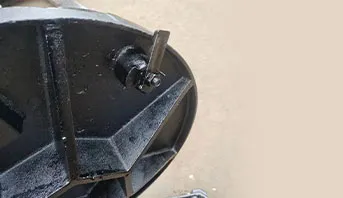Innovative Designs for Barbed Wire Fences to Enhance Security and Aesthetics in Various Settings
Designing Barbed Wire Fences A Practical Guide
Barbed wire fences have long served as a critical component of agricultural, industrial, and security applications. Their rugged design and effective deterrent capabilities make them an ideal choice for boundary demarcation and livestock management. In this article, we will explore the fundamental aspects of barbed wire fence design, including materials, construction techniques, and considerations for effective implementation.
Materials
The primary material used in barbed wire fencing is galvanized steel, known for its durability and resistance to rust. The wire is produced in various gauges—thicker wires provide enhanced strength but may be more challenging to handle and install. The standard barbed wire consists of two strands of wire twisted together, with evenly spaced barbs protruding outward. These barbs can vary in shape and size, depending on their intended use; the most common style features barbs spaced 12 inches apart.
Fence Design Considerations
When designing a barbed wire fence, several key factors should be taken into account
1. Purpose of the Fence Understanding the primary function of the fence is crucial. For instance, if the fence's main purpose is to keep livestock in, a lower height may suffice. However, if the goal is to deter potential intruders, a taller and more robust design might be necessary.
2. Height and Number of Strings A standard barbed wire fence typically consists of three or four horizontal strands. When considering height, a fence of at least 5 to 6 feet is often effective for keeping in larger animals such as cattle or horses. More strands can provide extra security but may also increase the cost.
3. Post Selection The choice of posts is essential for ensuring the stability and longevity of the fence. Wooden posts are traditional and offer a rustic aesthetic, while metal or concrete posts provide greater durability and resistance to weather elements. The spacing of the posts is also crucial; generally, posts are placed 8 to 12 feet apart to provide adequate support.
4. Ground Conditions The type of terrain and soil condition will influence the fence design. In rocky or uneven terrain, deeper post holes may be necessary, or additional bracing may be required to secure the fence. Conversely, in soft soil conditions, a proper foundation can help prevent leaning or sagging over time.
barbed wire fence design

5. Local Regulations Always be mindful of local zoning laws and regulations regarding fencing. Some communities may have specific height restrictions or requirements regarding fencing materials and designs.
Installation Techniques
Implementing a successful barbed wire fence requires careful planning and execution. Here are important steps to consider during installation
- Preparation Begin by marking the fence line and clearing any obstructions. Ensuring a straight line can simplify the installation process and create a more aesthetically pleasing result.
- Post Installation Dig post holes to the appropriate depth (typically at least 2 feet for stability) and set the posts in concrete or packed soil. Allow the cement to cure fully before tensioning the wires.
- Attaching the Wire Begin at one end of the fence, attaching the barbed wire to the posts using wire clips or staples. Ensure that the wire is taut but not overly stretched, as this can lead to breakage. A tensioning device can be beneficial for maintaining consistent tension along the length of the fence.
Maintenance
Finally, regular maintenance is essential to prolong the life of a barbed wire fence. Inspect the wire for signs of wear or rust and replace any damaged sections promptly. Additionally, keep vegetation trimmed back from the fence line to prevent interference and ensure visibility.
In conclusion, barbed wire fences represent an effective and versatile solution for a wide range of fencing needs. By considering the design parameters, materials, and installation techniques outlined here, one can create a robust, functional, and aesthetically pleasing fence that serves its intended purpose for years to come.
-
Space-Saving Chain Fence Hacks Vertical Gardening with Cyclone MeshNewsJul.16,2025
-
Innovations in Iron Nail Wire Production for Modern ConstructionNewsJul.16,2025
-
Creative Uses of Wire Netting Fence in Modern Landscape DesignNewsJul.16,2025
-
Barbed Wire Fence Innovations in Anti-Climb TechnologyNewsJul.16,2025
-
Architectural Uses of Umbrella Nails for Aesthetic Roof DesignsNewsJul.16,2025
-
Architectural Uses of Razor Barbed Wire in Secure Urban DesignNewsJul.16,2025




